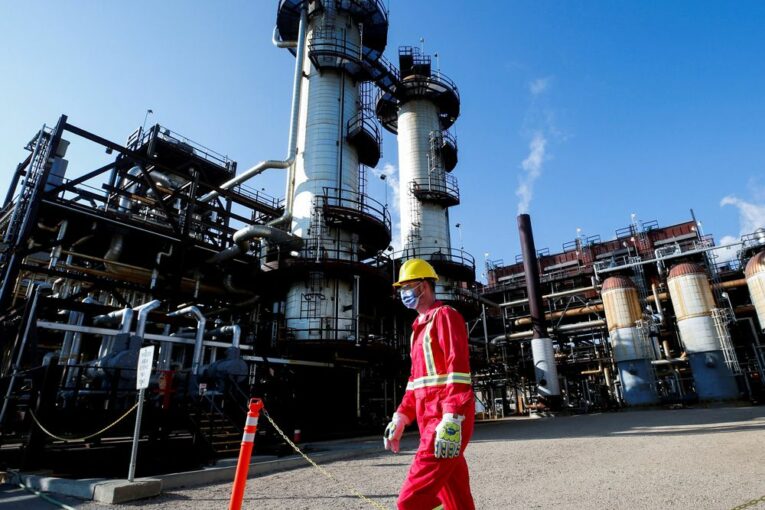
[ad_1]
A new report casts doubt on recent claims by oilpatch leaders that more government support will be needed before large investments in carbon capture technology can proceed.
Recent changes to industrial carbon pricing rules in Alberta, the province with the highest greenhouse gas emissions in the country, should be sufficient to trigger private investment in large-scale carbon capture and storage projects, according to a the Pembina Institute, which urged governments not to offer further incentives to industry.
Updates to Alberta’s Technology Innovation and Emissions Reduction Regulation (TIER) regime introduced in December increase the stringency of the tax on industrial emitters, while offering incentives to reduce emissions with the the introduction of new credits for carbon capture, utilization and storage (CCUS).
The changes will allow emitters to receive credit for the same emissions reduction under both the federal Clean Fuel Regulations and the provincial TIER system.
“It’s significant because it provides additional support for decarbonization projects,” said Jan Gorski, Pembina’s program director for oil and gas. “It allows companies to stack TIER offset credits with credits from the Clean Fuel Regulation, so it increases the financial incentive.”
The Pembina report says the changes augment an existing suite of incentives for decarbonization, including: a federal investment tax credit for CCUS, carbon pricing that will increase to $170 per tonne by 2030 and credits for emissions reductions under federal clean fuel regulations. The report’s authors argue that with the addition of another federal carbon policy expected later this year, called carbon contracts for differences, there should be sufficient incentives in place to offset risk of investing in CCUS.
“(It) means that no further measures — such as changes to Alberta’s oilsands royalty system — are needed, and there is sufficient up-front and sustained support for CCUS projects to progress to final investment decision in Alberta,” the report said.
The danger highlighted in Pembina’s report, according to Gorski, is that governments go overboard on incentives for the oil and gas industry in a bid to speed up the energy transition.
If the province comes in and gives them a really favourable royalty treatment, taxpayers start to shoulder that cost
Jan Gorski
“If the province comes in and gives them a really favourable royalty treatment, taxpayers start to shoulder that cost,” Gorski said. “And there’s this question of, ‘How should we be using that taxpayer money right now?’ Is the best place to use it to give it to industry, or should we be using it to address some of the other concerns: inflation, affordability. Striking that balance is really important.”
Following a year where oil and gas prices soared over supply concerns triggered by Russia’s invasion of Ukraine, energy companies have come under increased pressure from governments and some investors to spend some of their windfall profits on reducing greenhouse gas emissions.
However, oil and gas firms have been hesitant to deploy significant capital on expensive decarbonization projects, in part due to a lack of “certainty” that carbon prices won’t collapse or be eliminated altogether by future political leaders.
Meanwhile, many energy executives have argued that the U.S. Inflation Reduction Act, which will unleash billions in green subsidies south of the border, could draw investment dollars away from Canada if Ottawa doesn’t act quickly to implement similar incentives. And oilsands executives, who have banded together to advocate for more government assistance to the sector, have suggested that further supports — including a potential break on provincial oil and gas royalties — will be necessary to making large-scale decarbonization projects economically viable.
But that line of argument has not convinced some critics, who argue that energy companies won’t act until achieving low emissions production becomes a question of survival.
“If the companies and the shareholders came to believe that low emissions production was existential, that people were not going to insure or permit continued oilsands production without this technology, then that changes the game — but I don’t think (they) see it that way,” said Andrew Leach, an energy and environmental economist at the University of Alberta.
“I think they still see it as, ‘I’ll do this — if I get a return on capital,’ as opposed to, ‘I’ll do this because it allows me to continue using the capital I already have,’” Leach said. “If the industry believed fundamentally that that was the trade off, then it changes the financials tremendously.”
Canada’s approach to encouraging investment in emissions reductions so far has been criticized in some quarters for relying too much on “sticks” and not enough on “carrots,” and for the layering of complex policies sometimes aimed at accomplishing the same goal.
Still, some longtime observers of the sector are confident that 2023 could finally see the logjam broken and dollars unleashed for major decarbonization projects.
“We’ll see movement on (final investment decisions) for carbon capture and storage this year,” Peter Tertzakian, economist and managing director at ARC Financial Corp, said in an email.
“Canada is an attractive place for (CCS) to work, but that assumes all the policies will endure. It’s hard to assess the uncertainties over the life of big investments, but I think we’re at a point where developers are figuring out the layers of policy and their collective impact/risk. “
• Email: [email protected] | Twitter: mpotkins
[ad_2]
You can read more of the news on source
